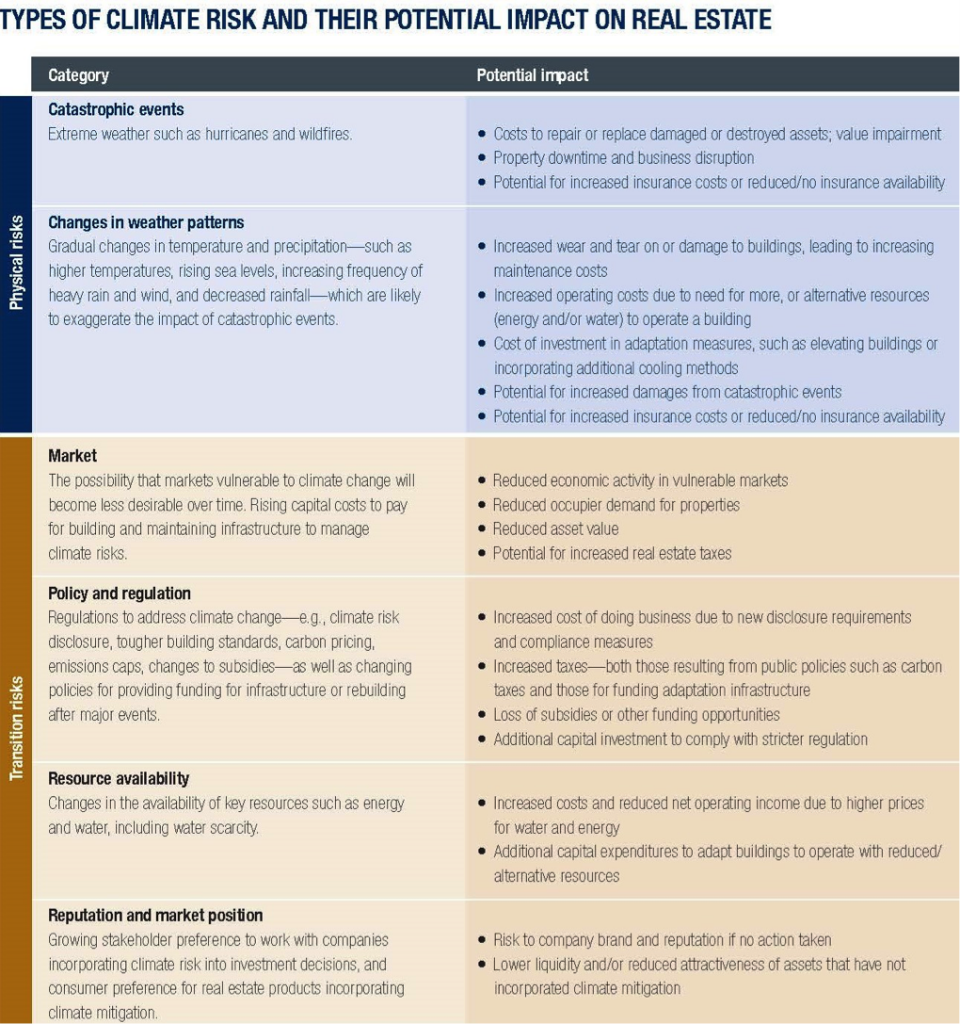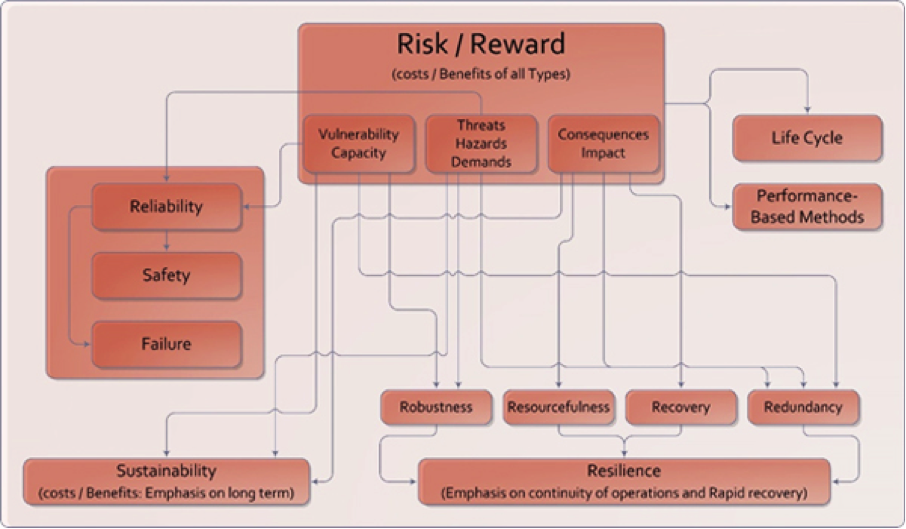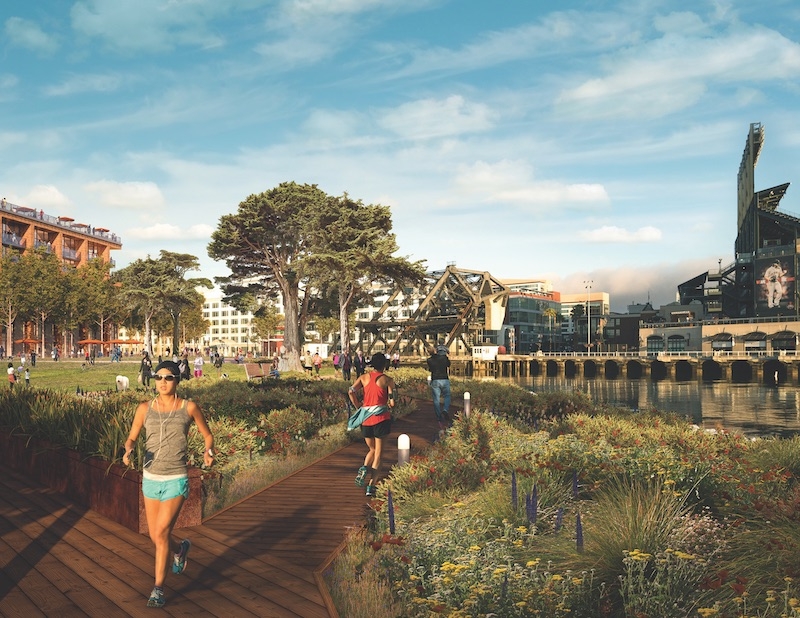By Paul L. Jones, CPA, May 13, 2019
In his legal commentary posted on April 1, 2019, my colleague, Rick Jones, a partner with Dechert LLP, a leading law firm serving the Commercial Real Estate Debt Market, opened with “I’m finally writing about climate change… not because 97 out of 100 scientists are shouting at us incessantly about the need to do something, but because I am dead certain that there are real and fairly immediate risks associated with the public reaction to the perception or awareness (take your pick) of the climate change risk which will drive regulatory intrusion on both the state and federal level, will drive legislation and moreover, will inform market reaction to lenders, investors, developers and their properties because of their climate change posture or profile.”
 The esteemed Mr. Jones continues: “Where do we start? We are already seeing some commercial real estate owners begin to adapt to regulatory change. Look at the fantastic engineering marvel which is the Hudson Yards, built 40 feet above sea level, with its storm management system and its fortress-like power system designed to survive a mega storm. That’s expensive. It was clearly purpose driven. We should ask what made them, a bunch of smart folks, put up the money. I guarantee it wasn’t frivolous. I would suggest to you that it’s a sign of things to come. More generally, we are also seeing more solar, more green building technology and more innovations in engineering and in general more willingness to pay real money to address environmental concerns.”
The esteemed Mr. Jones continues: “Where do we start? We are already seeing some commercial real estate owners begin to adapt to regulatory change. Look at the fantastic engineering marvel which is the Hudson Yards, built 40 feet above sea level, with its storm management system and its fortress-like power system designed to survive a mega storm. That’s expensive. It was clearly purpose driven. We should ask what made them, a bunch of smart folks, put up the money. I guarantee it wasn’t frivolous. I would suggest to you that it’s a sign of things to come. More generally, we are also seeing more solar, more green building technology and more innovations in engineering and in general more willingness to pay real money to address environmental concerns.”
New York has a wet climate, and water – from hurricanes, flooding, storm surges and even blizzards – is one of its primary environmental challenges throughout the year. Of course, buildings in NYC also endure seismic activity, high heat loads in the summer, power outages, manmade disasters like those produced by terrorist attacks as well as high humidity and year-round precipitation.
On the Pacific coast, seismic considerations are a primary concern as well as danger from wildfires, flash floods, and drought.
For most of my career serving the real estate industry, I have primarily conducted due diligence and providing underwriting and financial feasibility analyses for buyers, investors, lenders and capital market participants.
We usually start with a checklist of due diligence and underwriting items which typically includes:
- reviewing historical operating statements and related reports,
- abstracting leases and tenant correspondence records,
- getting a title abstract, checking the flood zone,
- obtaining and reviewing a property condition assessment (PSA) and a Phase 1 environmental site assessment (ESA), and
- evaluating all legal and contractual arrangements that may affect the income and expenses of the property.
But, if you are like most real estate investors, you have missed one item which affects all properties and portfolios: the risk resulting from climate change and sea level rise as well as man-made hazards: You still do not know how sustainable and resilient the income and future value from your investment is.
Beginning about five years ago, my clients started to ask questions regarding the potential effect of climate change and sea level rise on the sustainability and resiliency of the property.
- It is important to note that the risk to real property assets – which are immovable by their nature – exists regardless of whether you believe humans have caused climate change, or not.
- In fact, my client chose to divest of assets in Miami in order to buy assets in locales without the risk of sea level rise and our screening process involved an informal, yet substantive, assessment of the risk from climate change – no matter the location of the property.
In an article entitled “What does resilience mean for commercial real estate” by Ryan M. Colker published in the September/October issue of BOMA Magazine, he opens with the following observation:
“Around the world, the frequency, intensity and impacts of natural disasters are increasing. These events can significantly affect the social, economic and environmental functionality of communities. The ability of commercial buildings and the businesses they house to adequately prepare for such events and quickly return to full operations—a quality known as resilience—contributes significantly to a community’s ability to bounce back. In addition to the community-wide impacts, the state of individual buildings also can affect the long-term viability of the businesses that occupy those buildings.”
For a multi-family, commercial or industrial building, we at Emerald Skyline define building resilience as “the ability of the systems and structure to protect, maintain or restore the value of, functionality of, and income generated by a property after a damaging event or calamity – whether it is from a weather event or a man-made circumstance – within a pre-determined acceptable timeframe.
- A widely-cited 2005 study by the Multi-hazard Mitigation Council (MMC) of the National Institute of Building Sciences “documented how every $1 spent on mitigation saves society an average of $4.
- In a 2018 interim update report by the MMC found that costs and benefits of designing all new construction to exceed select provisions in the 2015 IBC and the IRC and the implementation of the 2015 International Wildland-Urban Interface Code (IWUIC) resulted in a national similar benefit of saving $4 in future losses for every $1 spent on additional, up-front construction costs.
In a report published last month (April 2019) by the Urban Land Institute (ULI) and underwritten by Heitman LLC (Heitman) entitled “Climate Risk and Real Estate Decision-making,” the authors note that:
“In 2017, the year Hurricanes Harvey and Maria hit the United States and storms battered northern and central Europe, insurers paid out a record $135 billion globally for damage caused by storms and natural disasters. This figure does not represent actual damages, which in the United States alone equaled $307 billion, according to National Oceanic and Atmospheric Administration estimates.”
In the Foreword, Ed Walter, Global CEO, ULI, and Maury Tognarelli, CEO, Heitman, highlight the need to address sustainability and resiliency:
“Failure to address and mitigate climate risks may result in increased exposure to loss as a result of assets suffering from reduced liquidity and lower income, which will negatively affect investment returns. At the same time, investors who arm themselves with more accurate data on the impact of climate risks could help differentiate themselves and benefit from investing in locations at the forefront of climate mitigation.”
And the industry – especially among institutional investors – is taking note. “Many leading investment managers and institutional investors are undertaking flood, resilience, and climate vulnerability scans of their portfolios. These mapping exercises seek to identify the impacts of physical climate risks on their properties, including sea-level rise, flooding, heavy rainfall, water stress, extreme heat, wildfire, and hurricanes. Potential impacts being considered range from physical access and business disruption for tenants to the effects that longer-term temperature increases or increased wear and tear on buildings could have on operating and capital expenditure requirements. The ultimate objective for the investment community is to understand how climate will affect asset liquidity and, as a result, returns, in terms of both income and capital growth.”
The results of the survey conducted in preparation of this report, the researchers found that industry participants continue to rely on insurance companies to cover potential losses from physical damage due to a natural disaster – but they astutely point out that insurance “does not protect investors from devaluation or a reduction in asset liquidity.” They categorize the climate risks either physical or transitional risks as follows:
- “Physical risks are those capable of directly affecting buildings; they include extreme weather events, gradual sea-level rise, and changing weather patterns.
- “Transition risks are those that result from a shift to a lower-carbon economy and using new, non-fossil-fuel sources of energy. These include regulatory changes, economic shifts, and the changing availability and price of resources.
“The location-specific physical threats posed by factors such as sea-level rise, hurricanes, wildfires and forest fires, heat stress, and water stress are among the most easily observable risks to real estate investment. They are a particular concern since many key markets for real estate investment are in areas exposed to the physical impacts of climate change.
These risks and their potential impact on real estate is summarized in the following table.
So far, according to the ULI report, “…most investment managers and investors for directly held assets currently use insurance as their primary means of protection against extreme weather and climate events.” However, “leading companies in the industry … are modifying existing decision-making and management processes to add climate and extreme weather-related factors to those being considered alongside other risks and opportunities.
The National Infrastructure Advisory Council (NIAC) in a 2009 repot characterized resilience as having four key features known as the “4-Rs”:
- Robustness: the ability to maintain critical operations and functions in the face of crisis.
- Resourcefulness: the ability to skillfully prepare for, respond to and manage a crisis or disruption as it unfolds.
- Rapid recovery: the ability to return to and/or reconstitute normal operations as quickly and efficiently as possible after a disruption.
- Redundancy, back-up resources to support the originals in case of failure that should also be considered when planning for resilience
From the Whole Building Design Guide, a program of the National Institute of Building Sciences (NIBS), understanding the relationship between Asset (Building) resilience and the community’s resilience requires an understanding of the distinctions and relationships between risk, resilience and sustainability as follows:
- Risk is expressed as the relationship between a particular hazard or threat that may degrade, or worse, devastate, the building’s security, operations and functionality and the consequences that result from this degradation of performance.
- Resilience is the ability of a building or asset to recover from, or adjust, easily to misfortune or change. The ability to prepare and plan for, absorb, recover from, or more successfully adapt to actual or potential adverse effects as reflected in the aforementioned Four Rs.
- Sustainability of an asset is determined by its ability to meet the needs of the present while being able to maintain its functionality over time without not being harmful to the environment or depleting natural resources.
The following diagram created by Mohammed Ettouney and Sreenivas Alampalli in their books on Infrastructure Health in Civil Engineering, presented the relationship of threat, vulnerability and consequences to risk as follows:
Recognizing the need for sustainability and resiliency due diligence, Emerald Skyline Corporation has developed a Sustainability and Resiliency Assessment (SaRA Rating©) Rating system to provide commercial real estate investors with a complete picture of the risk associated with a particular property or investment. The information not only helps investors and owners but also provides lenders, insurers and tenants with information relevant to their decisions.
SaRA Rating© incorporates an assessment of the physical attributes of the property – including incorporation of information obtained from traditional due diligence procedures with additional procedures to determine the relative risk, resiliency and sustainability of the property over the investment horizon.
- The physical review of the property is conducted in conjunction with the Phase I environmental site assessment and the property condition assessment and includes a review of the property’s resiliency features like hardened walls, raised electronic and network connections, secondary systems.
No building operates in a vacuum: Its resiliency, in particular, is directly connected to its location and is directly affected by the surrounding neighborhood, the community, and natural and man-made risks (hazards).
Based on a property-specific assessment including use of mapping services, our team of professionals evaluate a building’s resiliency and sustainability resulting in a rating from 1, not resilient or sustainable (High Risk) to a 5 (Highly Resilient). Our objective is to provide investors with the information they need to make prudent investment decisions that account for the physical, environmental and social risks to the cash flow stream and market value of the building.
At the conclusion of our procedures, we identify land and building improvements that would enhance a property’s resiliency and sustainability. The economics of each improvement or enhancement is assessed in a cost-benefit analysis.
We then evaluate the tradeoffs between performance of a building over its life-cycle and the cost of improving the building systems to ensure its sustainability and resiliency. Accordingly, we evaluate the total cost of ownership (TCO) by determining the capital cost of the property including any improvements plus the present value of the future expenses of operations, maintenance, utilities and the estimated cost to recover from a calamity.
Further, armed with the SaRA Rating© and report, the stakeholders can incorporate current and prospective tenant/user demand for the space in the building given the cost of occupancy and resiliency as well as investor demand and potential pricing for the asset. A resilient and sustainable asset will combine low-cost operations due to sustainably-reduced energy and maintenance costs and managed insurance expenses while maximizing the net cash flow and long-term value of the property.
The objective of all due diligence – including and especially the assessment of all the risks of ownership – is to optimize the overall returns on the investment while quantifying and minimizing the risks and costs to achieve those goals – that is the purpose of Emerald Skyline’s Sustainability and Resiliency Assessment Rating© system – your one-stop resource to measure and manage climate risk in the real estate industry.
For more information, contact Paul L. Jones, CPA, Phone: 786-468-9414; email: PJones@EmeraldSkyline.com



